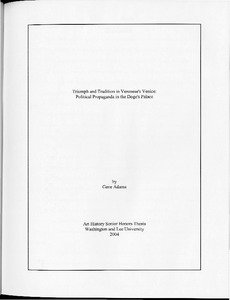Triumph and Tradition in Veronese's Venice: Political Propaganda in the Doge's Palace

View/
Author
Adams, Gene Golden
Subject
Washington and Lee University -- Honors in Art History
Narrative painting, Italian -- Themes, motives
Italy -- Venice
Metadata
Show full item recordDescription
Works such as the Triumph of Venice seem only ornate, skillfully painted images of allegory and overblown state glory. Yet upon further inspection, the relationship of this work to the Paradise connects the power of the state to both the justice of Solomon and the pure Christianity of the Virgin. Not only evoking state pride, these images in tandem target the power of the Pope by reminding Venetians of the holy birth of the state independent of Roman Christianity. The painting on the far wall of the Maggi or Consiglio again strikes at the papacy; compositionally aligned with the Triumph of Venice and Paradise with figures arranged in horizontal bands, The Return of Doge Andrea Contarini to Venice after the Battle of Chioggia shows Church hierarchy in place of Jesus and Venetia in the top figural tier. Rather than angels and joyous citizens across the bottom of the canvas, prisoners are shown wrestling against their chains. . . . Taken together, the historical context of Venice in the late sixteenth century and the history of the doge reveal the motives and the propagandistic nature of the art of the Doge's Palace created after the fires of 1574 and 1577. These paintings supported the anti-papal leanings of Nicolo da Ponte while furthering the goals of the giovani for Venetian government to return to traditional utilitarian objectives. [From Conclusion]